ARATI KUMAR-RAO
Environmental photographer and writer Arati Kumar-Rao travels across South Asia in all seasons to chronicle the subcontinent's changing landscape. Here, in photos and in her own words, she captures the increasing threat climate change poses to the lives and livelihoods of the Ladakhi people, who face an uncertain future below the melting glaciers of the Himalayan mountains. Kumar-Rao is one of this year's Climate Pioneers on the BBC 100 Women list.
IMAGE SOURCE,ARATI KUMAR-RAO
Image caption,Snowfall is becoming increasingly erratic in the Ladakh region, disrupting farming and agricultural patterns
The night of 5 August 2010 is still fresh in the memory of the people of Ladakh, in northern India, when it felt like a cloud had burst over the area surrounding the capital, Leh.
One year's worth of rain fell on the cold desert in just two apocalyptic hours. Massive walls of sludge swallowed up everything in their path. Scrambling people were buried mid-stride under a thick brown-grey mass.
Several hundred people were never found after that fateful night.
The Ladakh region, the northernmost plateau of India, sits more than 3,000m (9,850ft) above sea level. The Greater Himalayan Range shields the region from the annual monsoon that much of the rest of India relies on.
Until recently, Ladakh has been bathed by the sun for 300 days per year, while barely four inches of rain have fallen on the vast landscape of rock and mountains. Floods were virtually unheard of.
IMAGE SOURCE,ARATI KUMAR-RAO
Image caption,Animal rearing is one of the most important and major livelihoods of Ladakhi people
The destructive flood of 2010 was followed in quick succession by further floods in 2012, 2015, and most recently, in 2018.
Something that had not happened in seven decades, occurred four times in fewer than 10 years. Such freak weather events are a result of climate change, experts say.
IMAGE SOURCE,ARATI KUMAR-RAO
Image caption,June 2018: Meltwater from winter snow sustained wetlands in spring that livestock and wildlife depended upon. Unpredictable snowfall means they are now unreliable.
A decade and a half ago there used to be a regular rhythm to the Ladakhi land, which provided villagers with a steady water supply. Winter snow melted to feed streams, just as meltwater from the glaciers trickled down and provided water for farming and agriculture in springtime.
IMAGE SOURCE,ARATI KUMAR-RAO
Image caption,Increasing numbers of goatherds are giving up the profession in response to the changing landscape
IMAGE SOURCE,ARATI KUMAR-RAO
Image caption,Spring and summer is traditionally a time of plenty in Ladakh
However, climate change has seen average winter temperatures in Ladakh rise by about 1C over the last 40 years.
Snowfall has become increasingly unpredictable and glaciers have retreated farther up towards the peaks, or disappeared altogether.
IMAGE SOURCE,ARATI KUMAR-RAO
Image caption,Spring 2023 (left) compared to Spring 2019 (right) in the village of Stok
I first visited Ladakh in 2018. I returned in 2019, and again in spring this year - kept away in the interim by the coronavirus pandemic. The difference was startling.
The snow now melts faster, leaving villagers with little to no water by spring. Glaciers are now so high up in the mountains that they melt later in the year. Ladakhi springtime - once lush and fertile - was dry and silent this year.
A lack of water has led to a decrease in meadows - keeping large flocks of pashmina goats is becoming unviable. The Changpa herders are giving up their traditional livelihoods and migrating to other parts of India or to Leh looking for non-pastoral work.
Farmers, unable to find water for their barley and apricots, are leaving in droves.
IMAGE SOURCE,ARATI KUMAR-RAO
Image caption,Apricot farmers are forced to work in an increasingly dry environment
IMAGE SOURCE,ARATI KUMAR-RAO
Image caption,Many Ladahki people have relied on apricot farming for decades
Despite the destruction caused by climate change, there is hope for this isolated region.
On my second visit to Ladakh in March 2019, I met engineer Sonam Wangchuk. He told me that on a drive through the valleys in 2013 he noticed a large mound of unmelted ice under a bridge, sheltered from the sun. The sight of that small tower of ice triggered an idea.
"High school maths tells us that a cone is the simple answer," he grinned at me.
ARATI KUMAR-RAO
Image caption,Sonam Wangchuk was determined to find a solution for his community
IMAGE SOURCE,ARATI KUMAR-RAO
Image caption,Workers assemble pipes to bring water down to the valley from the mountain peaks
Wangchuk wanted to help villagers freeze water in winter which could be saved for use in spring. Freezing it in the shape of a cone would maximise the volume of ice per square metre of surface area exposed to the sun and lengthen the amount of time it would take to melt.
The engineer assembled a team of local people and began experimenting, looking for the best way of creating cones of ice. Eventually, they found the right formula.
IMAGE SOURCE,ARATI KUMAR-RAO
Image caption,Ice stupas now decorate the landscape
After piping water from a mountain stream down into the valley, the group forced water to flow up a vertical pipe with a fine nozzle attached to its end. The water went up the pipe and exited via the nozzle as a fine spray.
In night-time temperatures of -30C, the spray froze as it exited the pipe. Gradually, as more and more water emerged as spray and turned to ice, the edifice began to resemble a cone.
IMAGE SOURCE,ARATI KUMAR-RAO
Image caption,Children from the local school help to build Ladakh's ice stupas
Now named ice stupas, after Buddhist places of meditation, they have gained popularity all across Ladakh. The structures, some of which tower over 100ft (30m), provide a water supply for a community that has seen climate change disrupt its natural resources.
They also provide a surprising source of entertainment - hotly contested competitions for the tallest stupa take place annually.
But the injustice of the situation is not lost on either Wangchuk or his stupa-building friends. Ladakhi people are paying the price for carbon emissions made elsewhere.
ARATI KUMAR-RAO
Image caption,Ladakhis continue to try and survive on the front line of climate change
"It is not enough that we keep coming up with technical innovations, keep adapting, keep solving problems," Wangchuk tells me.
"I want to use ice stupas as much to sensitise the world about the need for a change in behaviour, as I want to use it to provide water for us."
As a photographer who has travelled across vast spaces of South Asia, I know Ladakh is not alone in its fight.
For the first time in history India and its neighbouring countries, China and Pakistan, face a common enemy - climate change. It has the potential to destroy river basins and threaten the most populated regions of the world. It may be time to come together to shore up resilience against this threat to survival.
Produced by Rebecca Thorn, BBC 100 Women.
Results 1 to 2 of 2
-
25-11-2023, 02:25 AM #1
Climate change: The villagers building 100ft ice towers
Shalom
-
25-11-2023, 02:37 AM #2
Great post
Wonderful apricots when I passed thru 5 decades ago like nearby Afghaistan Waziristan Hunza and Kashmir where minorities under pressure too.
Pakistanís Kalash people are afraid for their future after Taliban attack
http://www.bbc.com/news/world-asia-67498243
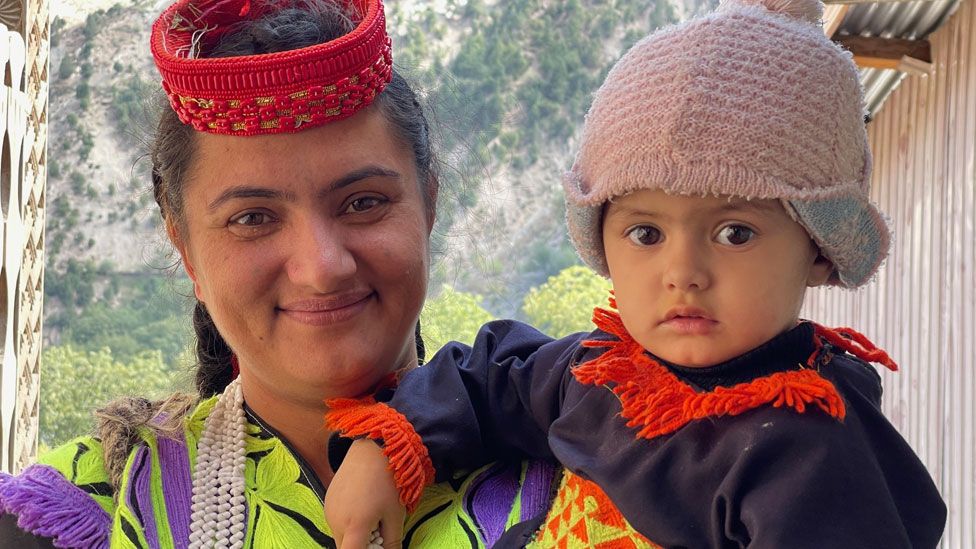
Image caption,Shaira is afraid Taliban militants will return to the Kalash valley
By Farhat Javed
BBC Urdu, the Kalash valley
Nestled in Pakistan's Hindu Kush mountains, the remote Kalash valley is a popular tourist destination. But a recent attack by Taliban militants has left people living there afraid for their future.
"It was 04:00 in the morning when we saw men coming down the mountain with turbans on their head, backpacks, weapons and belts of bullets around their bodies," says a Kalashi shepherd, Michael (not his real name).
He was taking sheep and goats to a nearby pasture with his father, uncle and a friend when the militants attacked their valley.
"There were Taliban everywhere, behind every rock and every tree. One was just a few steps away from me. There must have been more than 200 of them," Michael recalls. "We hid under big rocks and stayed there for 48 hours."
The Pakistani authorities sent in forces and say five security officers and at least 20 Taliban militants were killed in the fighting that lasted two days.
"There was an unusual stillness. Everyone was worried and scared. It felt like a war zone," says Shaira, a mother of two, as she recalls hundreds of troops, military vehicles, drones and attack helicopters hovering over the valley.
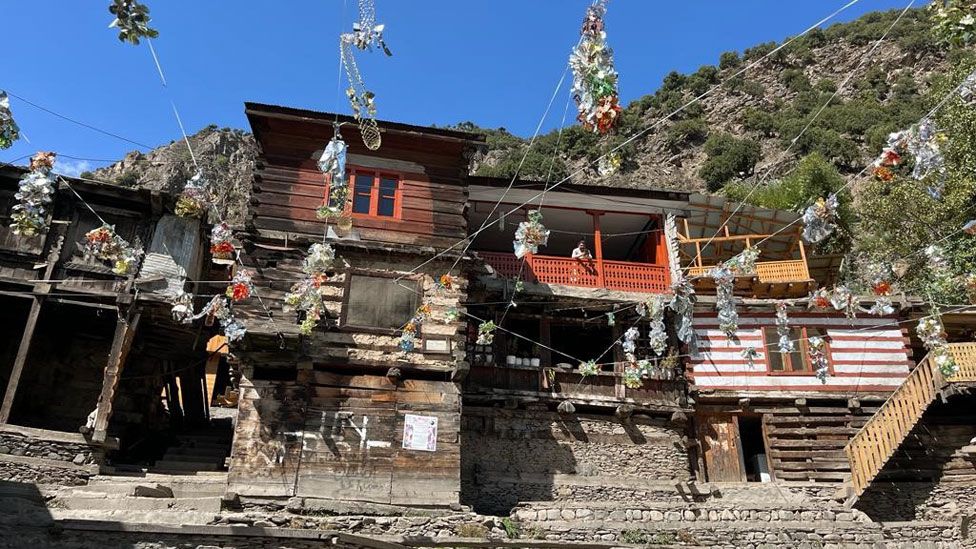
Image caption,A traditional home in the Kalash valley
Attacks like this have become more frequent in Pakistan in recent months, and although this assault in September took residents by surprise, sources within the government have confirmed they received information and intercepted a phone call hinting at an imminent attack at least a week before it happened.
The Pakistani Taliban, or TTP, said they carried out the assault, reportedly from over the border in neighbouring Afghanistan.
Pakistan has consistently accused Afghanistan's ruling Taliban of providing shelter to TTP members in provinces along its border with Pakistan and this is seen as one of the most significant cross-border attacks since the Taliban retook control in Kabul in 2021. The Taliban government denies the allegations it provides sanctuary to militants.
Authorities in Pakistan believe the aim of the assault was to take control of the strategically-important Kalash valley.
"Its capture would have given the TTP what they want, causing fear among people and a message to the world that they are strong," says Muhammad Ali, the district's deputy commissioner. But he points out: "Our security forces didn't let that happen."
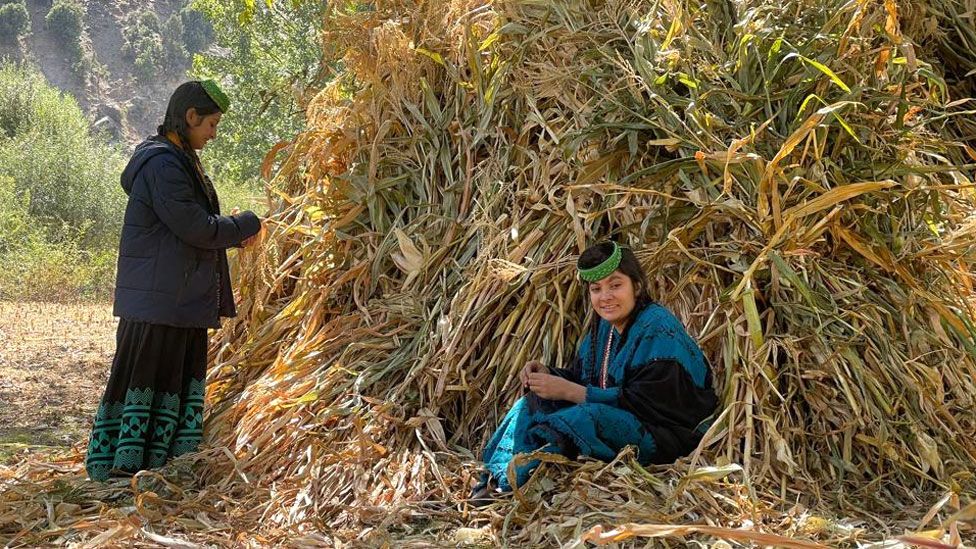
Image caption,The Kalash community relies heavily on farming
The attack has left the indigenous Kalashi community, 400km (250 miles) from Pakistan's capital Islamabad, feeling tense.
The people in this valley - who claim they are descended from Alexander the Great despite evidence that they are indigenous to South Asia - are renowned for their culture, religion and traditions that are distinct from Pakistan's Muslim majority.
But the joy they display in their dances and music has been overshadowed by a sense of fear, uncertainty and despair.
As Shaira cradles her one-year-old daughter, she explains that she came back to Kalash after finishing her university degree "to preserve their culture and unique religion".
The community worships a pantheon of gods and goddesses, holding festivals to mark the seasons and their links with farming. At these times women may declare their love, elope or even end their marriages.
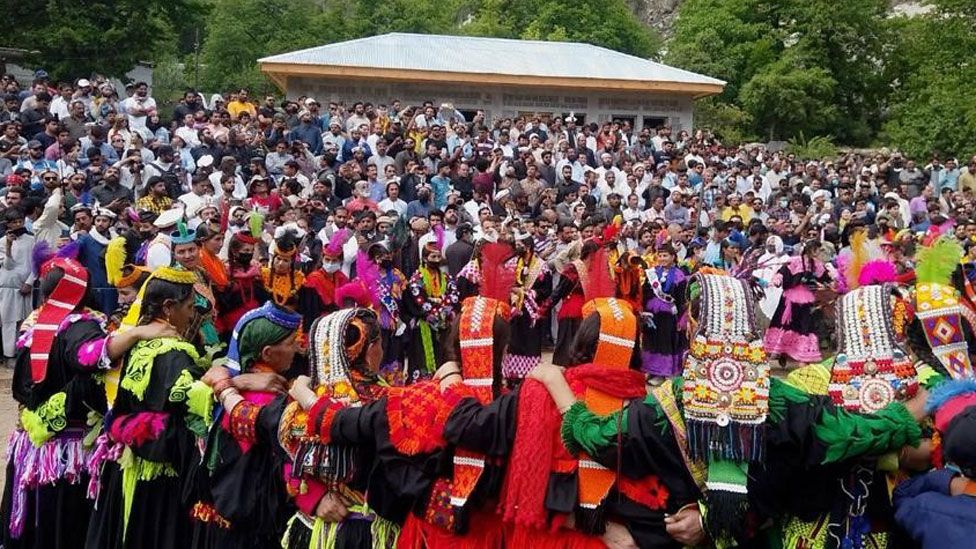
Image caption,Dancing and music are a central part of local festivals
But living in a maze of tiny houses, the people here also face challenges. Muhammad Ali says religious groups have been banned from the area "to control forced conversions by Islamist and Christian groups", but people in the Kalash valley claim they still face forced conversions and feel their religion and culture is in danger.
They now fear the latest attack represents a new wave of threats that could spell the end of their community. Many, like Shaira, are wondering what their options are. Where should they go if the Taliban attack again?
"Everyone said the Taliban had come for us Kalashis. They'll kill us or force us to change our religion," she says. "We don't have any resources to leave, so we have to stay in Kalash, dead or alive."
They are worried that attacks like this could also affect their livelihoods. The Kalash valley attracts a significant number of visitors each year from Pakistan and beyond.
The clash brought both tourism and shepherding in the area to a standstill, as the valley was closed for days. Foreign tourists were evacuated, locals were instructed to stay away, and all roads leading to the valley were barricaded. Troops were deployed, and the pastures became no-go areas.
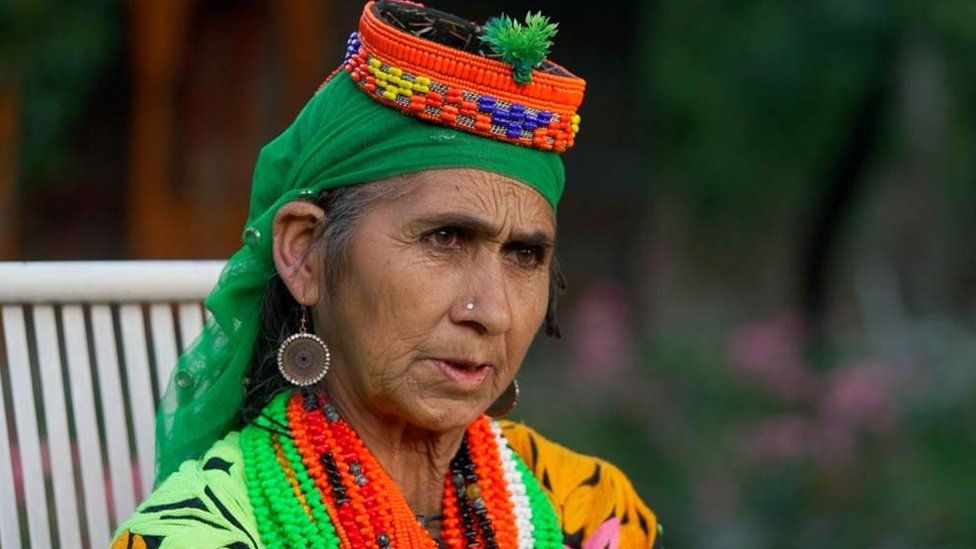
Image caption,Kalash community leader, Kai Meera, says the attack affected their income
"Tourists benefit us all, and after this attack, we faced shortages of essentials," says Kai Meera, a community leader. "We were also unable to take our livestock to the pastures, and there was a complete loss of income."
After the attack, Pakistan announced the closure of two main border crossings with Afghanistan, which resulted in substantial losses in trade revenue. Thousands of people were stranded at the border crossings for days.
Michael managed to leave his hiding place under the rock after 48 uncomfortable and terrified hours. His body had been bent over for so long he couldn't walk for a while.
Now back in his village, fear is a constant in his life.
"They [militants] used to cross the border in the past, but they would snatch our livestock at gunpoint and go back. This time they came to take our valley away. I think they'll come again," he says.
The deputy commissioner has tried to reassure Michael and the rest of the community, saying: "While it may take some time for the fear to subside, we have decided to fortify the border, increase the number of checkpoints, and bolster border security."
Shaira shares a parting thought as she leaves her baby sleeping soundly and heads to the fields to gather crops before the winter falls: "War is war, whether it's the Taliban or someone else. In the end, it's us, the unarmed people, who suffer and die."
Thread Information
Users Browsing this Thread
There are currently 1 users browsing this thread. (0 members and 1 guests)





 Reply With Quote
Reply With Quote






